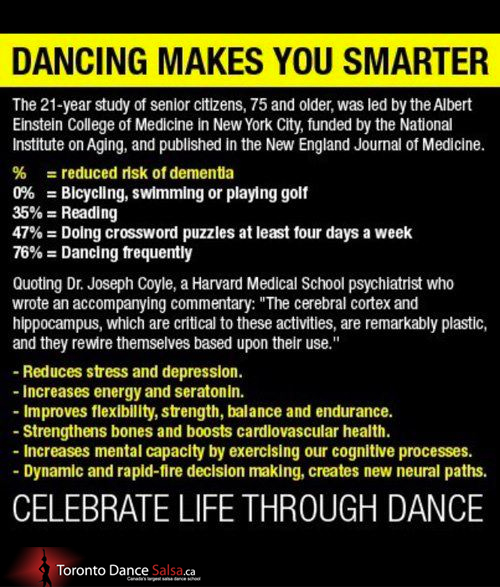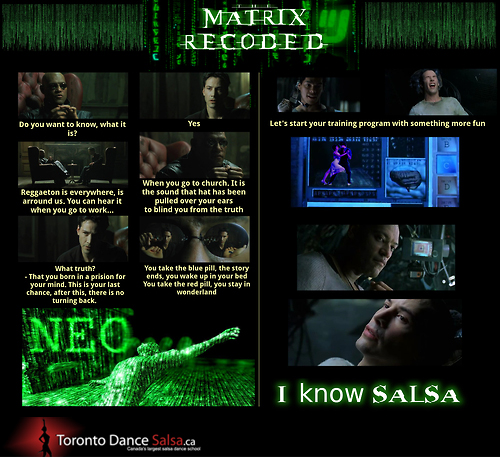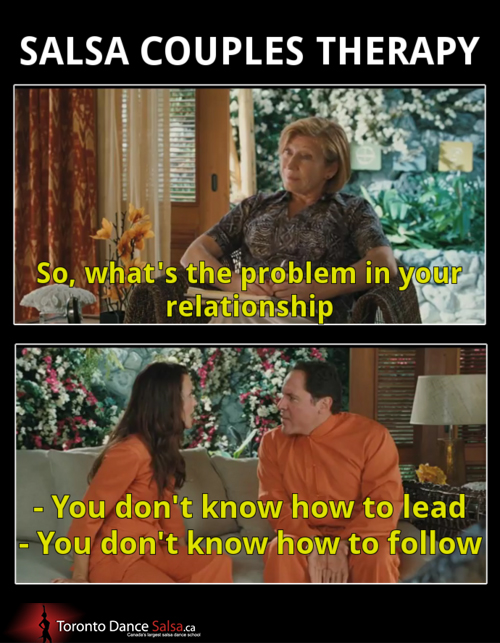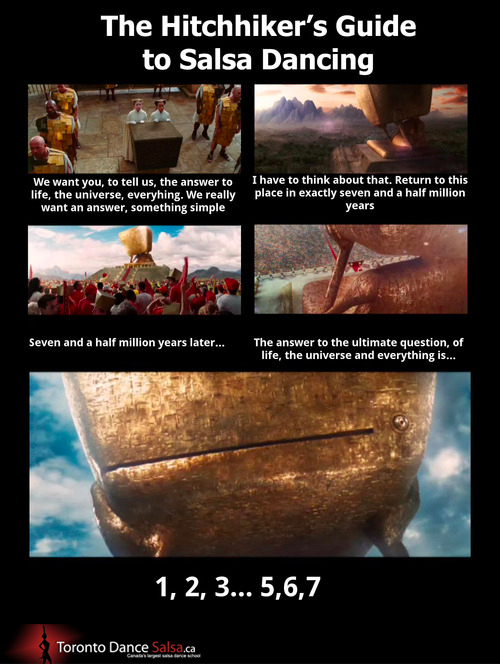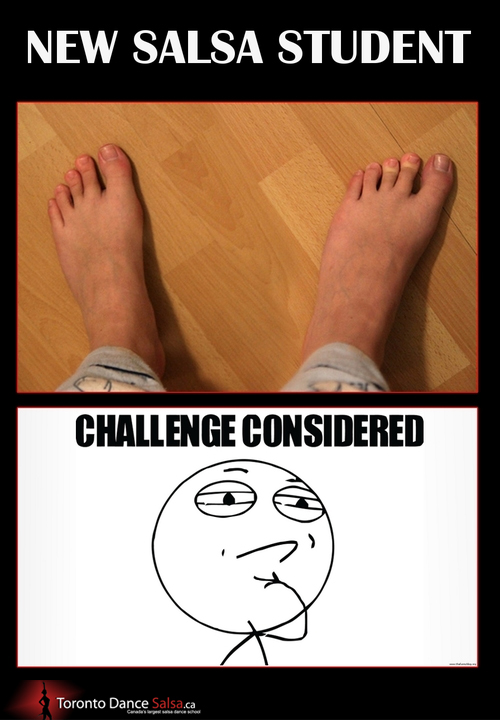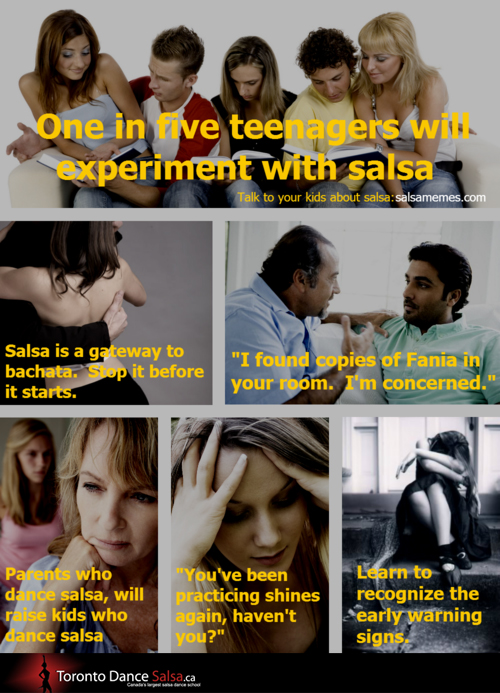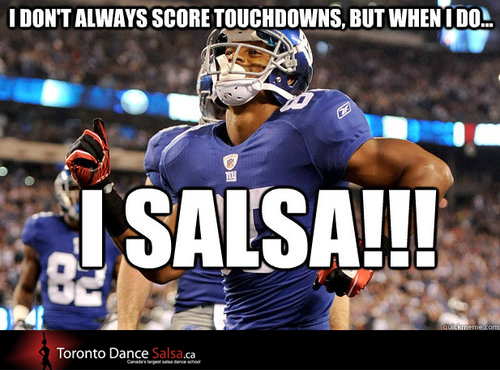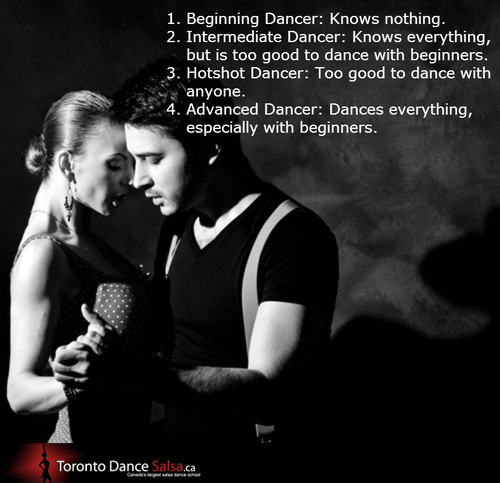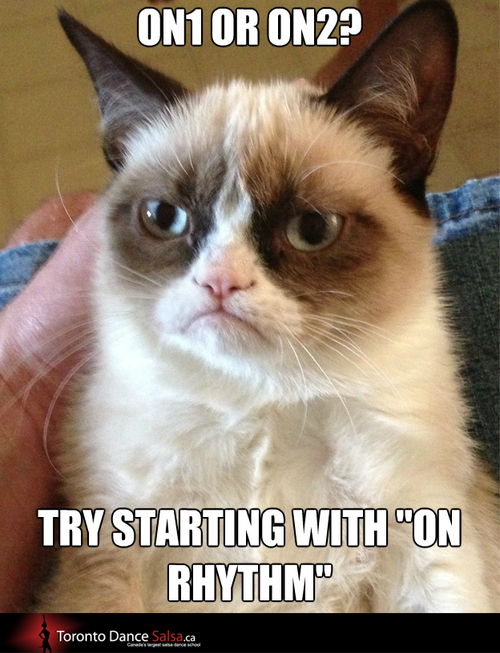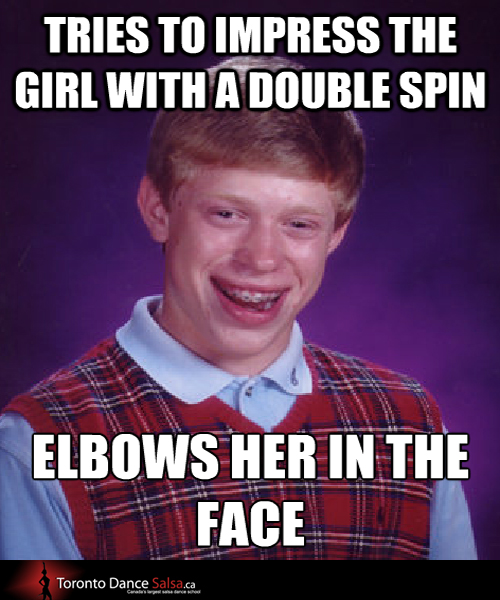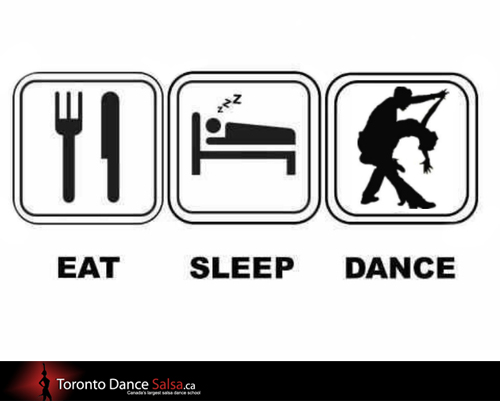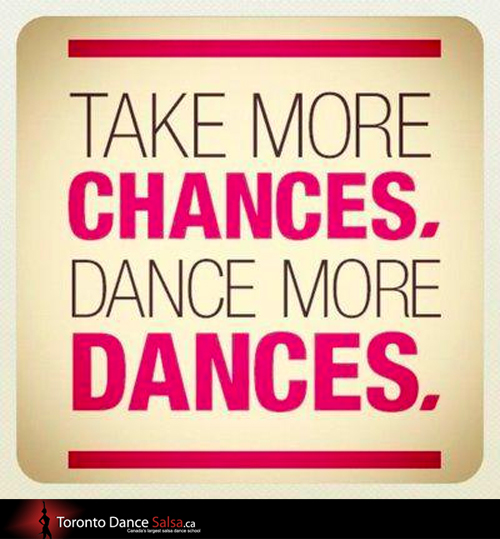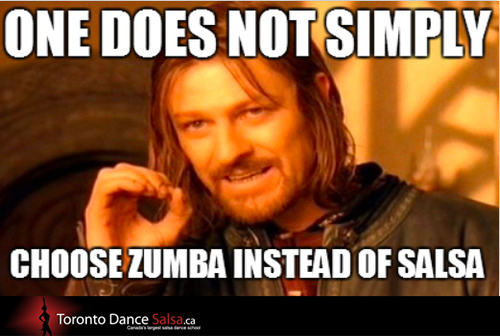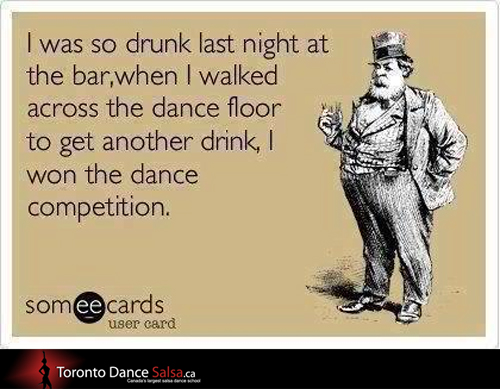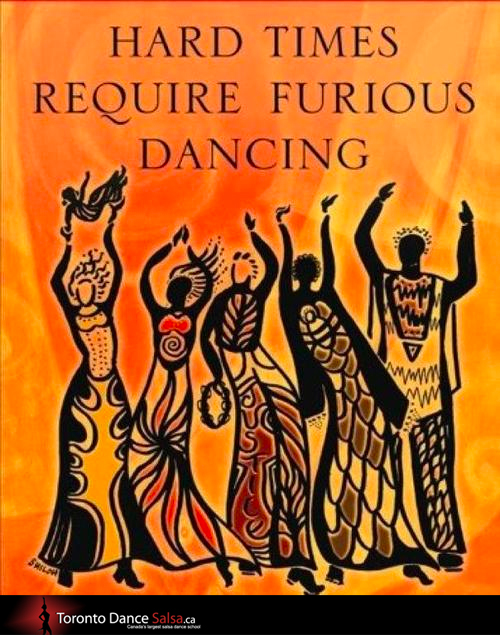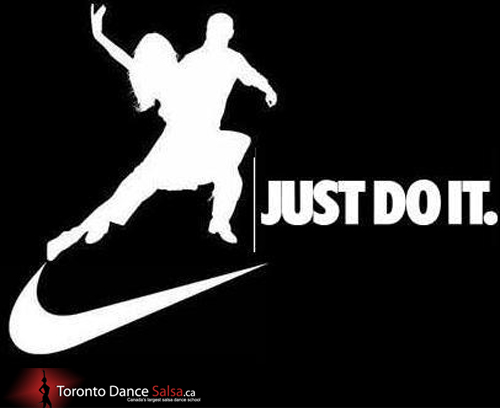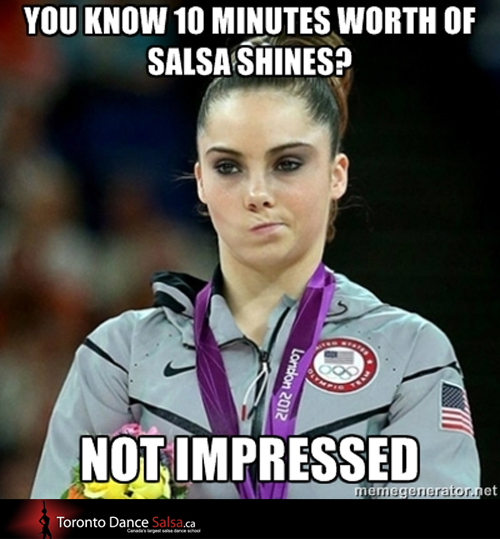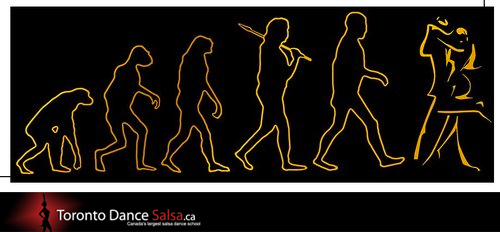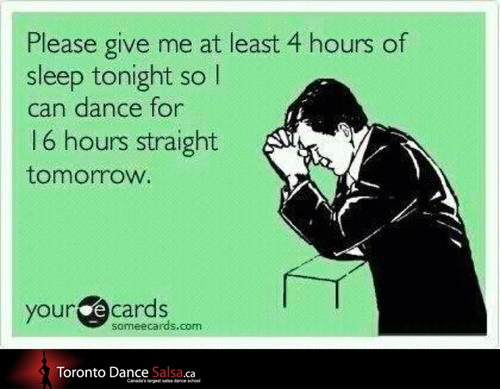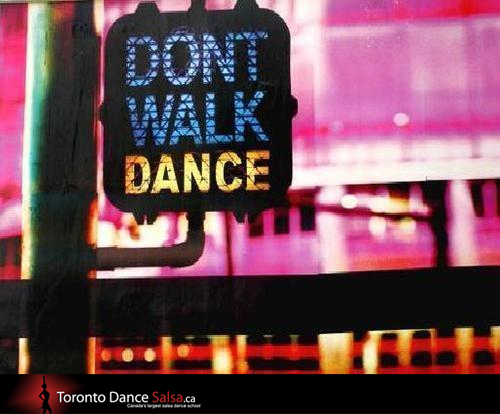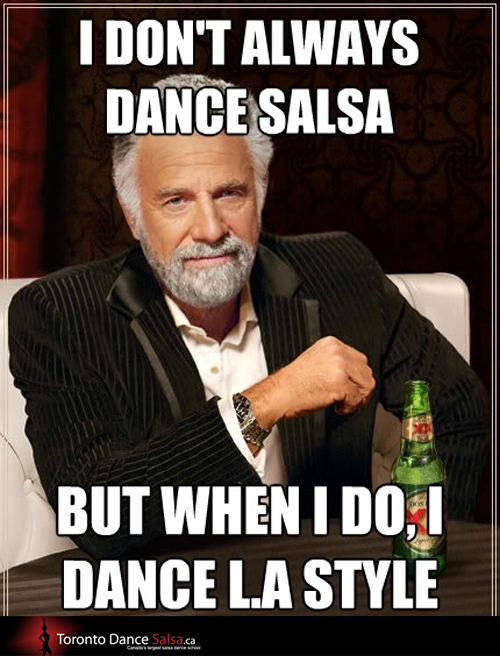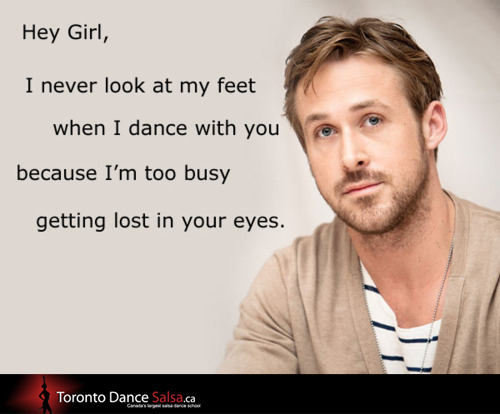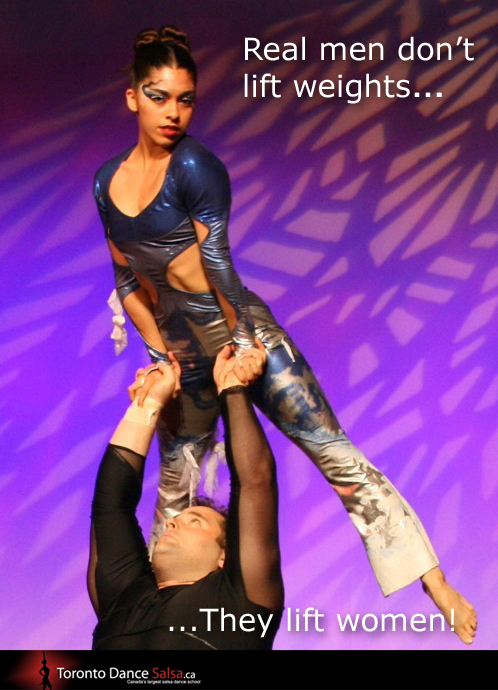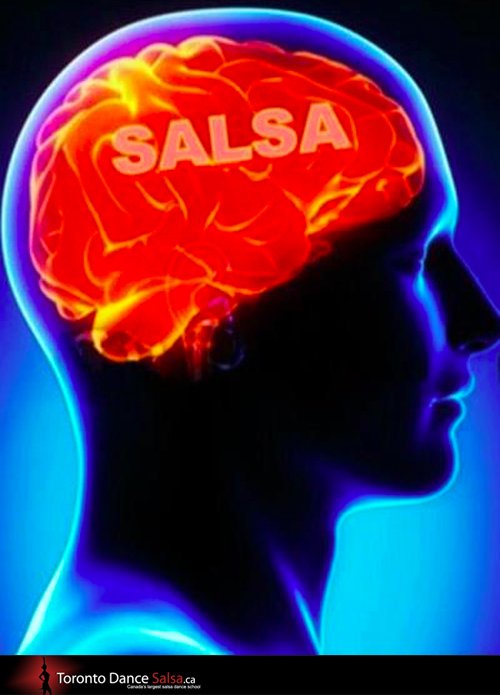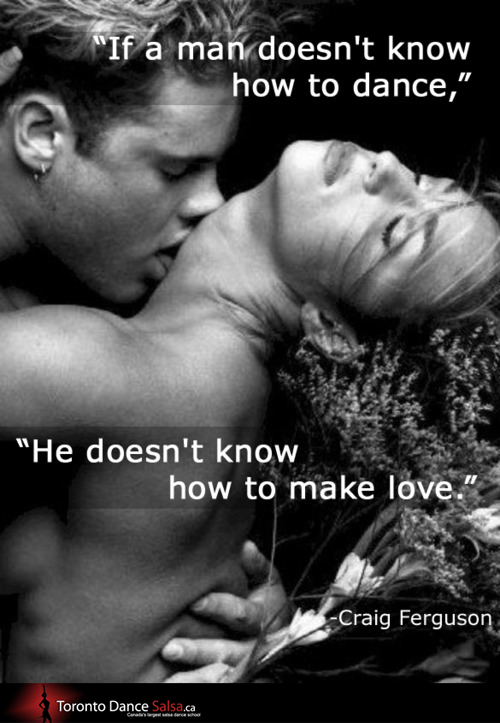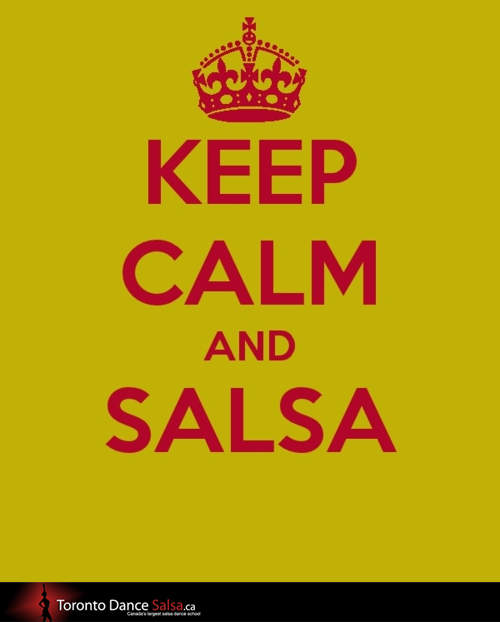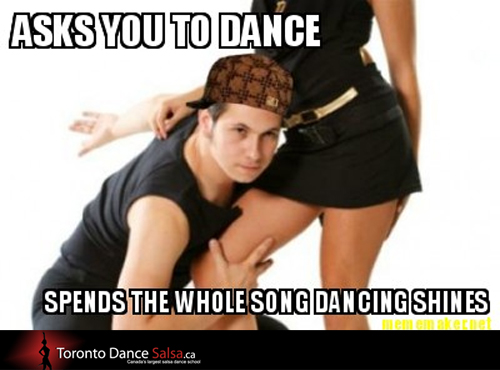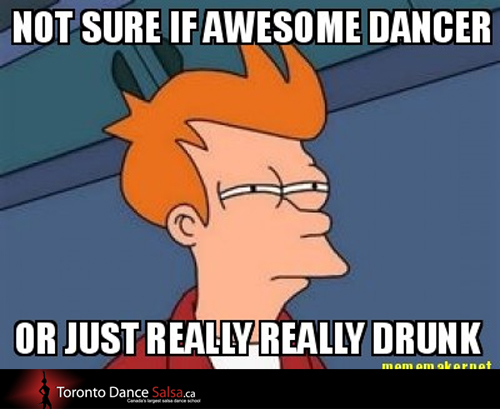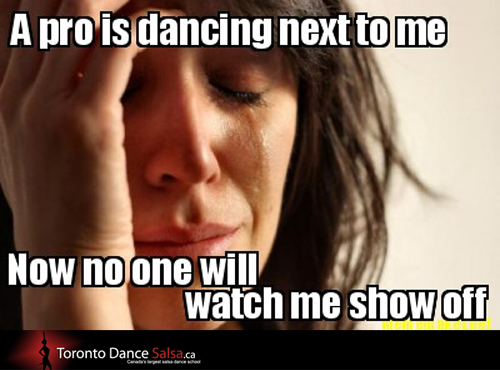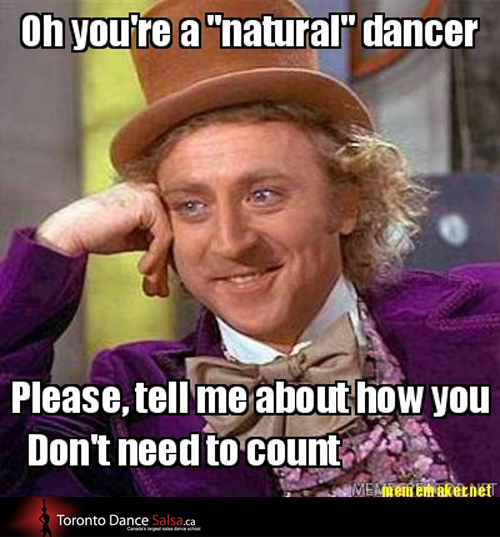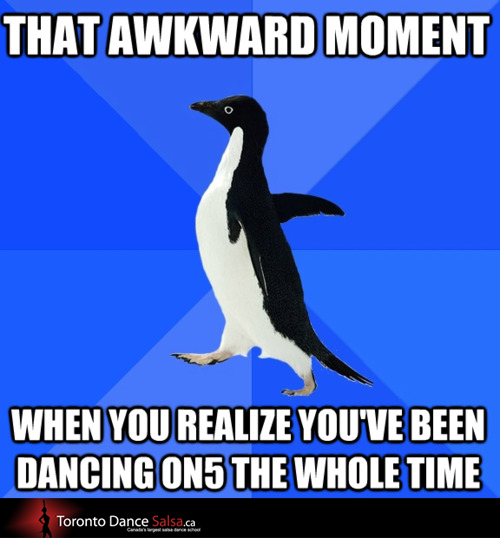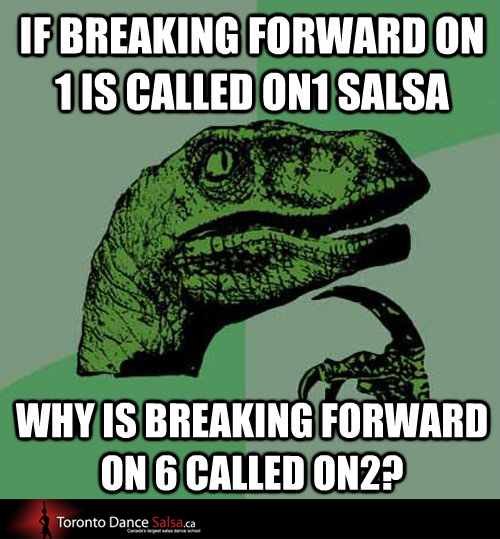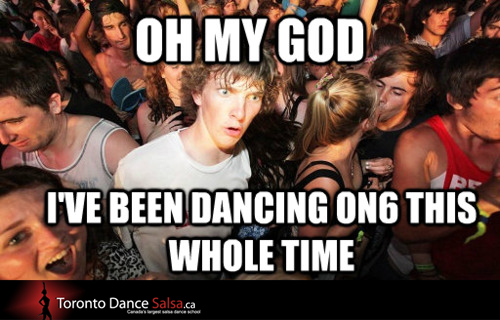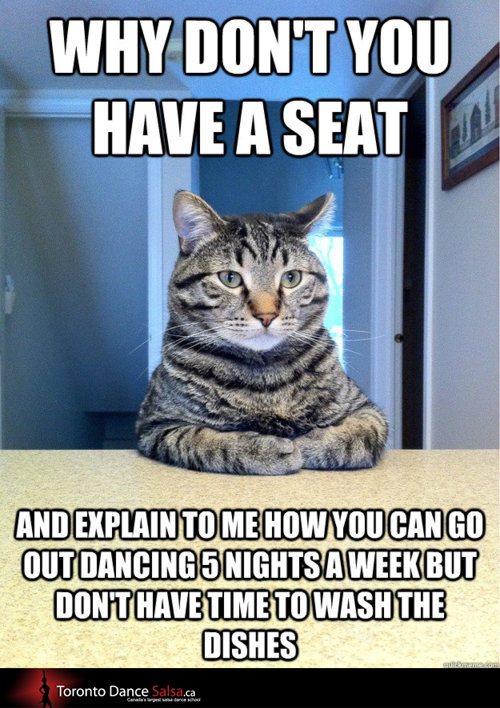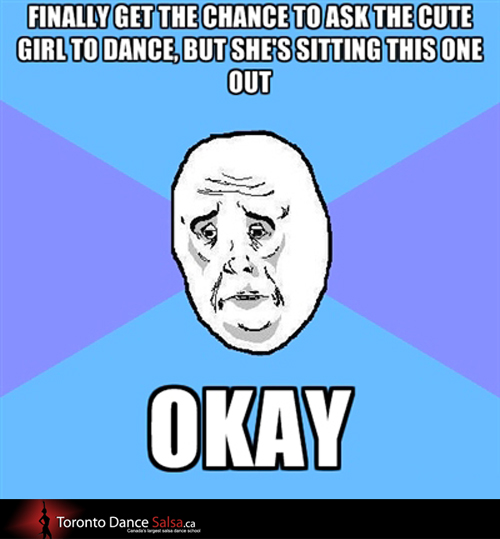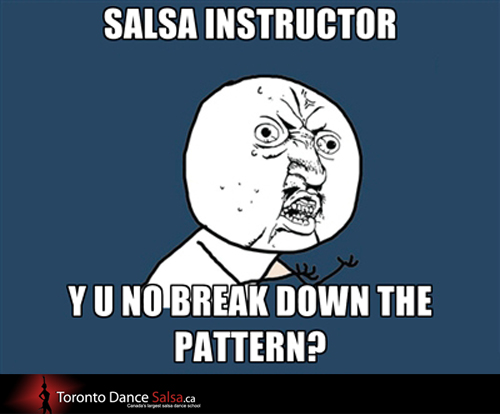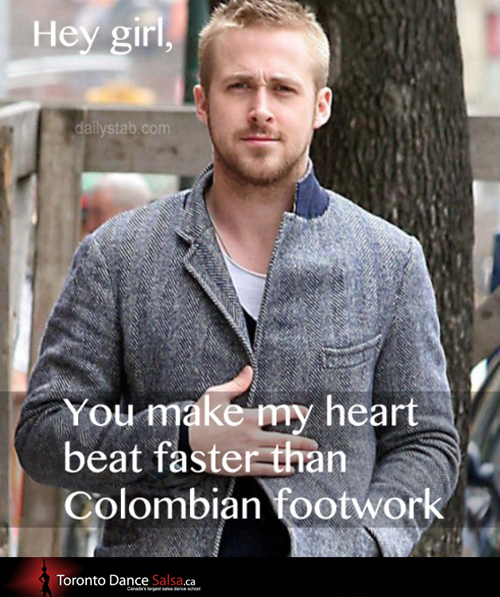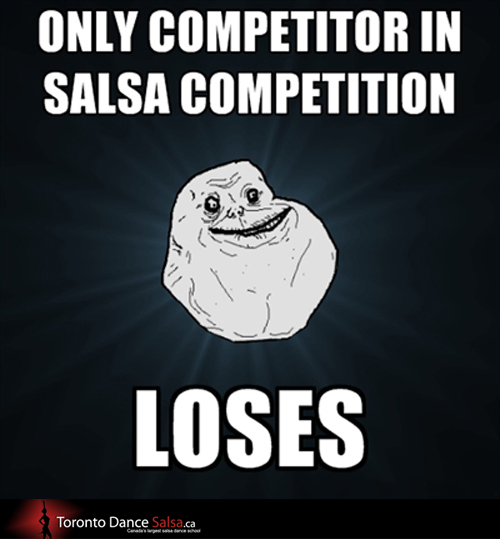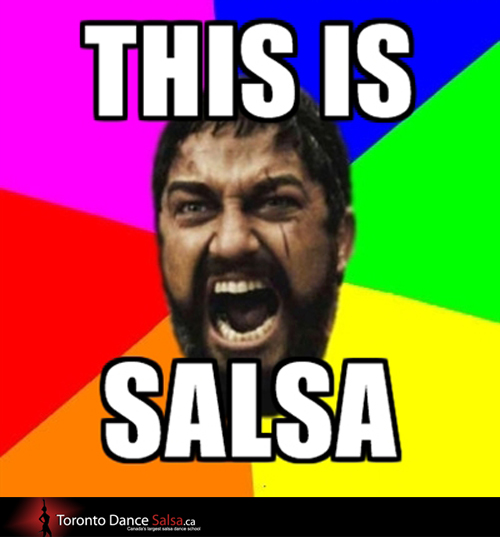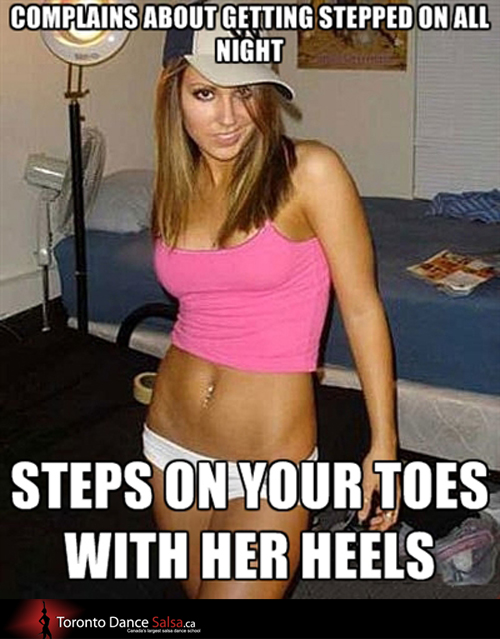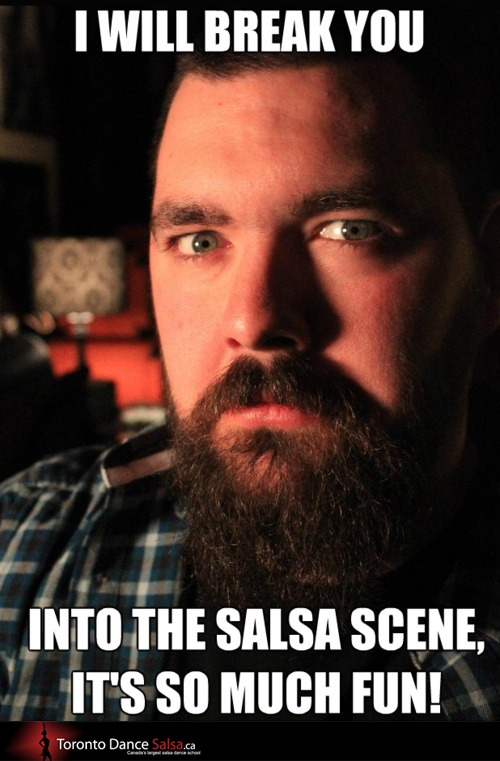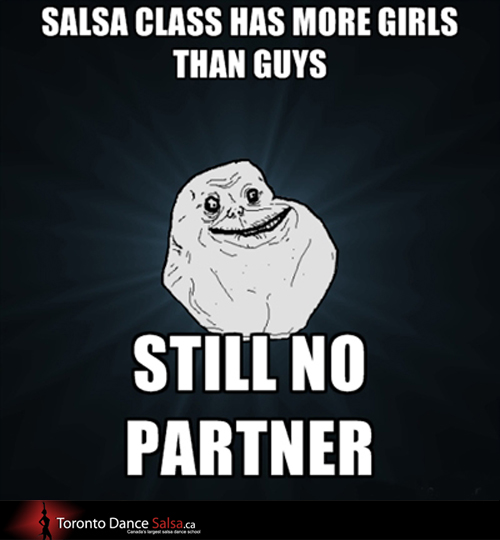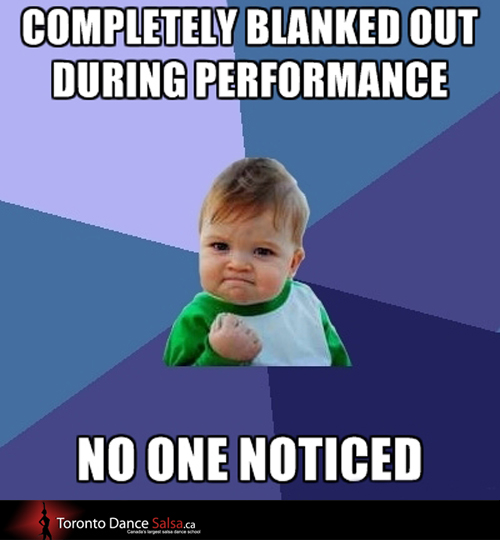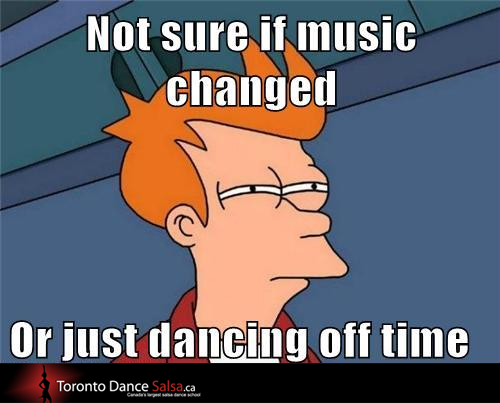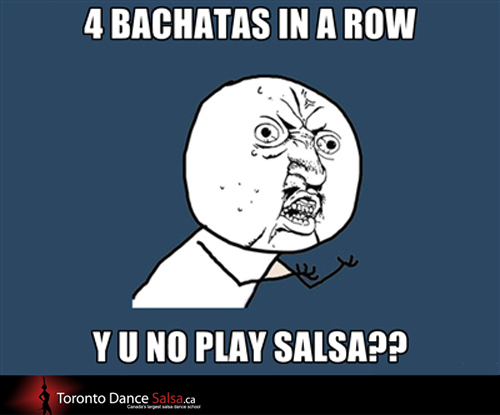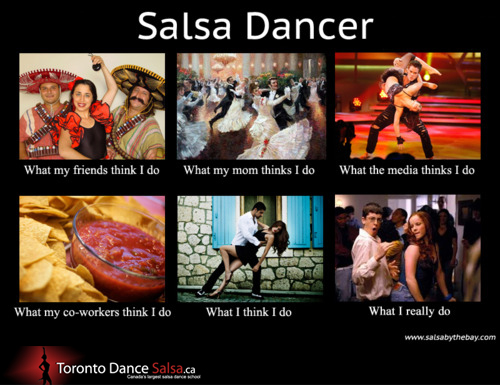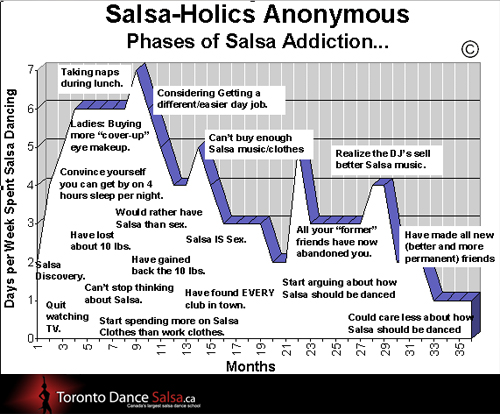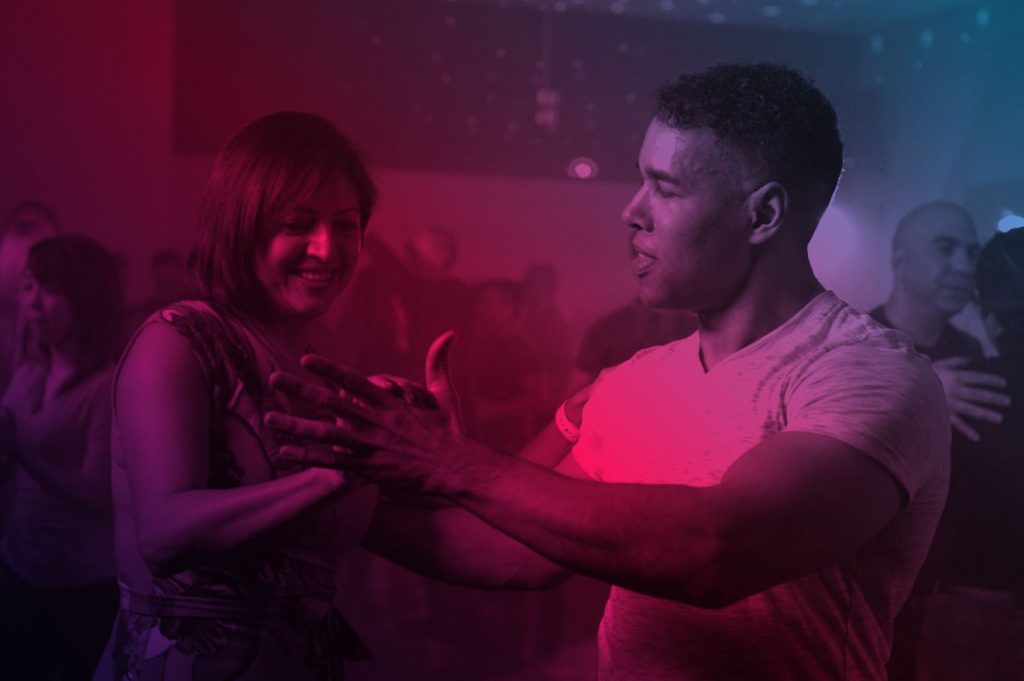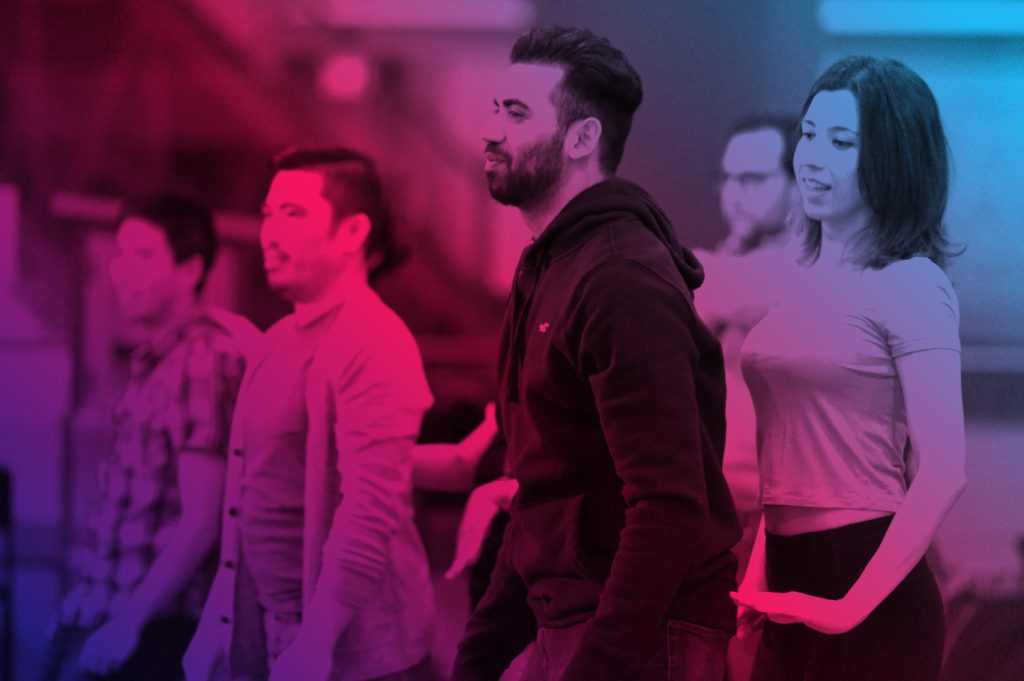What is Salsa?
The Salsa “Tree”
Quick facts: Distinguishing between “The Styles”
Music – The Founding Fathers and Mother
Music – Contemporary Artists
Music – How To Tell If It’s Salsa
Taking Lessons?
Choosing a School
What to Wear / What Not to Wear
Getting Past Being “Just a Beginner”
Going Out – Club Night vs. Outing vs. Social
Salsa Etiquette – 10 Simple Rules
Celebrity Salsa
Salsa On Screen
FUN: Salsa Memes
What is Salsa?
“Cuban & Puerto Rican musicians in New York coined the phrase in New York in the 1970’s.”
We’re talking about the dance, not the delicious South American condiment.
The origins of the word “Salsa” as the name of a dance has been a source of debate for decades. The most popular (and possibly accepted) theory is that Cuban and Puerto Rican musicians in New York coined the phrase in New York in the 1970’s, to describe the spicy fusion of music they were creating out of the rhythms and motifs of Cuban son montuno, guaracha, chachacha, mambo and bolero.
It is said that the evolution of the music drove the evolution of the dance – emigrants to North America from Cuba, Puerto Rico and Colombia in the 1920’s brought their dances and music to the neighborhoods and clubs of New York, Miami and Los Angeles. As the new form of “Salsa” music swept the continent in the 1970’s and 1980’s, those foundation dances – what we like to refer to as the “Roots” of salsa – morphed into the modern styles of “Salsa” (the dance) that we dance today.
The Salsa “Tree”
“There are several different styles of salsa and also different styles of salsa music.”
Salsa as a dance and music form now have wide spread popularity – there are several different styles of salsa and also different styles of salsa music. If you ask any individual salsa dance teacher, musician or performer what Salsa dancing or music is, you’ll likely get several different answers; so the question is, which answer is “right”? Actually, all of them are.
Let’s think of Salsa dancing and music as a great big Tree that looks like this:
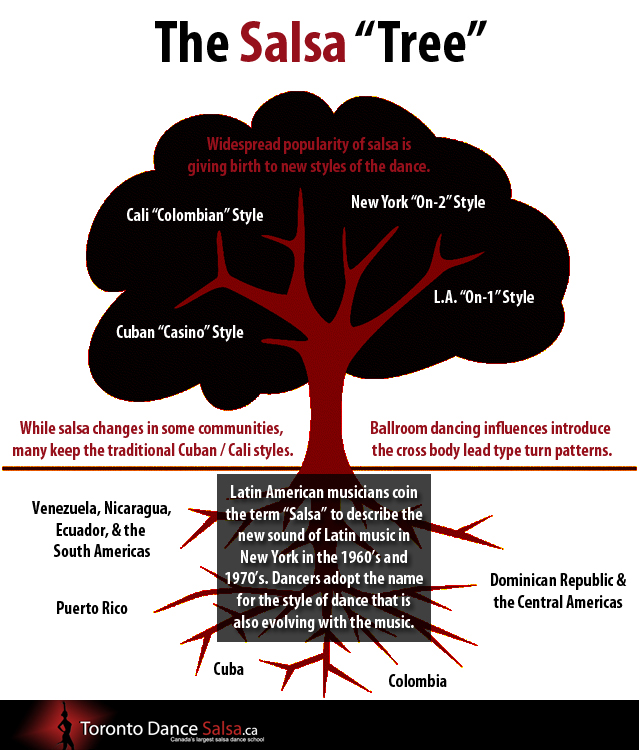
Quick facts: Distinguishing between “The Styles”
“There are several features of the main styles of Salsa that distinguish one from the other.”
Salsa is danced world-wide – while many technical aspects of the dance are the same across styles (6 steps over 8 beats danced on a quick-quick-slow or slow-quick-quick rhythm), there are several “hallmark” features of the main styles of Salsa that distinguish one from the other.
Cuban (Casino) Style
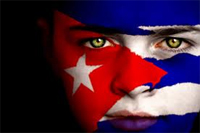 Also known as “Casino” style aside from being danced between two dancers (lead and follow), the figures in this style can also be danced in the “Rueda” (circle). Couples participating in a Casino Rueda dance all moves in unison as called by a Leader. Distinguishing features of Cuban style salsa are circular turn patterns (with “break back” steps on counts 1 and 5) as well as body movement inspired by traditional Afro-Cuban folkloric dances.
Also known as “Casino” style aside from being danced between two dancers (lead and follow), the figures in this style can also be danced in the “Rueda” (circle). Couples participating in a Casino Rueda dance all moves in unison as called by a Leader. Distinguishing features of Cuban style salsa are circular turn patterns (with “break back” steps on counts 1 and 5) as well as body movement inspired by traditional Afro-Cuban folkloric dances.
Cali (Colombian) Style
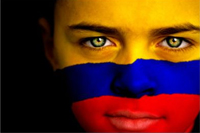 Distinguishing features of Cali style salsa is quick and intricate footwork, danced with a strong hand hold connection between partners. Unlike the other 3 prevalent styles of Salsa dancing, Cali style does not include the Cross Body Lead type patterns.
Distinguishing features of Cali style salsa is quick and intricate footwork, danced with a strong hand hold connection between partners. Unlike the other 3 prevalent styles of Salsa dancing, Cali style does not include the Cross Body Lead type patterns.
New York (a.k.a “On-2”) Mambo style
 The origins of the style are a topic of debate, but it is said that New York style Salsa dancing originated in the 1960’s due to the influx of Latin American emigrants after the Cuban Revolution. Eddie Torres is the most well known New York style dancer, being almost universally credited with popularizing the style to dance centres outside of New York. Distinguishing features of New York style have couples executing turn patterns and figures in the “slot”, with the break step on count 2 and 6, to synchronize steps with the beats of the clave and tumbao (congas). The basic rhythm of “On-2” is slow-quick-quick.
The origins of the style are a topic of debate, but it is said that New York style Salsa dancing originated in the 1960’s due to the influx of Latin American emigrants after the Cuban Revolution. Eddie Torres is the most well known New York style dancer, being almost universally credited with popularizing the style to dance centres outside of New York. Distinguishing features of New York style have couples executing turn patterns and figures in the “slot”, with the break step on count 2 and 6, to synchronize steps with the beats of the clave and tumbao (congas). The basic rhythm of “On-2” is slow-quick-quick.
Los Angeles (a.k.a “L.A. On-1”) style
 The “youngest” of the styles of Salsa, L.A. Style (some people have called it “West Coast” style) became popular in the 1990’s and has its origins in ballroom (Mambo, Swing and ChaChaCha). Turn patterns lead and follow techniques are heavily influenced by these styles, with the Cross Body Lead being the cornerstone of the style. Distinguishing features of L.A. Style are execution of turn patterns and figures in the “slot”, with the break steps on counts “1” and “5”. This style is also characterized by fancy and often intricate arm styling by the follow to accent the “1” and “5” counts. The basic rhythm of “On-1” is quick-quick-slow.
The “youngest” of the styles of Salsa, L.A. Style (some people have called it “West Coast” style) became popular in the 1990’s and has its origins in ballroom (Mambo, Swing and ChaChaCha). Turn patterns lead and follow techniques are heavily influenced by these styles, with the Cross Body Lead being the cornerstone of the style. Distinguishing features of L.A. Style are execution of turn patterns and figures in the “slot”, with the break steps on counts “1” and “5”. This style is also characterized by fancy and often intricate arm styling by the follow to accent the “1” and “5” counts. The basic rhythm of “On-1” is quick-quick-slow.
Music – The Founding Fathers and Mother
“Salsa didn’t really start to see a rise in popularity until 1970’s New York, with “Nuyorican” salsa bands and musicians (New York musicians of Puerto-Rican descent).”
While Salsa music has strong origins in Cuban, Colombian and Puerto-Rican folkoric traditions, it cannot be discounted that all Afro-Latin and Latin American cultures have contributed to contemporary Salsa music as we know it today.
Salsa music, in its modern version (as we know it today) has existed since the 1970’s – while “Salsa” music was in being played in the households and clubs of Latin Americans all over South and North America for much of the 1900’s, it can be argued that Salsa didn’t really start to see a rise in popularity (and widespread distribution into non-Latino communities) until 1970’s New York, with “Nuyorican” salsa bands and musicians (New York musicians of Puerto-Rican descent) such as Tito Puente, Johnny Pacheco (creator of the Fania All-Stars), Ray Barretto, Willie Colon, Larry Harlow, Eddie Palmieri and Hector Lavoe actively promoting, performing and celebrating the music style (and therefore, the dance) and making it accessible to non-Latino and Latinos alike.
It’s possible that due to political reasons the contribution of Afro-Cuban culture and heritage to contemporary Salsa in the 1960’s and 70’s is not widely recognized, but it cannot be ignored the huge contribution and influence of the “Queen of Salsa”, Celia Cruz. A household name in Cuba and the Central Americas as a singer in the 1950’s, Celia left Cuba for the U.S. in 1959 – making New Jersey her home. There she became friends with the Nuyorican musicians, and her collaborations with them and her time with the Fania All-Stars led to over 50 albums (of collaborative and solo work).
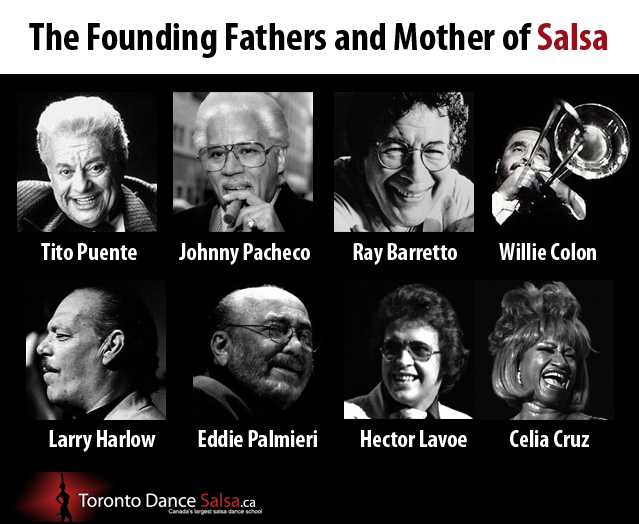
Music – Contemporary Artists
“The popularity of Salsa music, dance and culture has spread like wildfire.”
Thanks to the internet and ease of access to information, the popularity of Salsa music, dance and culture has spread like wildfire over the last 30 years – and even then contemporary Salsa artists continue to pay tribute to the Founding Fathers and Mother of Salsa. Contemporary artists such as Marc Anthony and Luis Enrique continue to produce and promote Salsa music and as such the music form continues to evolve.
Today Salsa music is created, performed and celebrated world-wide. In 2000 the influence of Latin American music and culture (not just Salsa) was recognized by the National Academy of Recording Arts and Sciences in the U.S. and the Latin Grammy Awards were created. The Latin Grammy’s have brought attention to the Salsa Legends and contemporary Salsa artists alike.
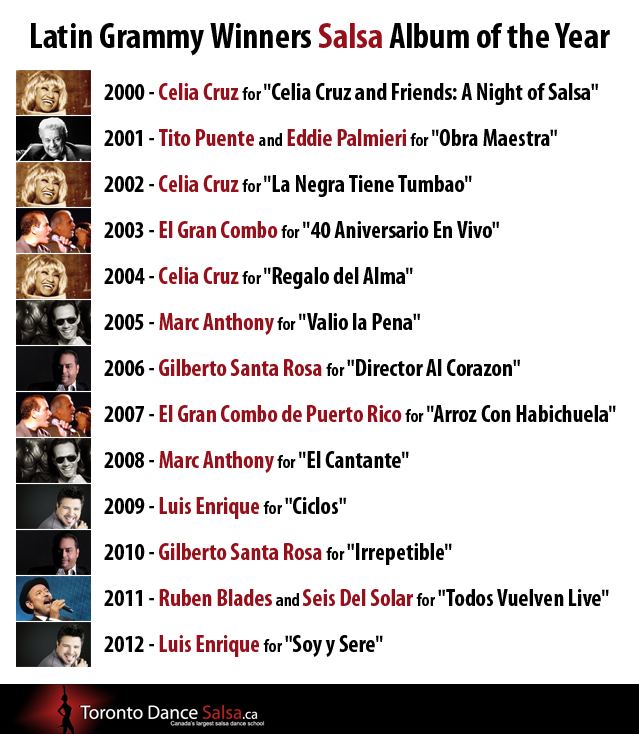
Music – How To Tell If It’s Salsa
“An easier way to describe Salsa music is how it does NOT sound like other types of Latin American popular music.”
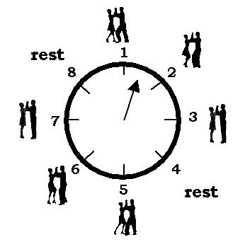 Since Salsa music has so many musical origins, it can be really difficult to distinguish between what is a Salsa song and what isn’t. distinguishing characteristics of Salsa music are: 4/4 time signature, Son Clave and Tumbao rhythms, Montuno Piano
Since Salsa music has so many musical origins, it can be really difficult to distinguish between what is a Salsa song and what isn’t. distinguishing characteristics of Salsa music are: 4/4 time signature, Son Clave and Tumbao rhythms, Montuno Piano
Unless you have a background in music, the above 3 characteristics probably mean nothing to you. An easier way to describe Salsa music is how it does NOT sound like other types of Latin American popular music.
Merengue is a straight 2 beat dance (almost no synchopation). Bachata is a straight 4 beat dance with a prevalence of a syncopated guitara line and a clear lack of any “hard” piano, brass (trumpet, trombone) lines. ChaChaCha resembles Salsa music the most as it feels like “really slow” salsa/mambo. ChaChaCha can be distinguished by it’s emphasis of the double tumbao beat on counts 4+5 and 8+1 (the “cha-cha-cha”)
Taking Lessons
“It’s always best to focus your efforts into developing muscle memory in one discipline before moving on to another.”
You’ve been to a Salsa night at a club and you’re hooked – you love the music, the energy, the look of two dancers gliding across the dance floor executing cool spins and turn patterns. You’ve tried one or two of the free classes offered at the clubs and while they’ve been fun you still can’t seem to “understand” salsa music or the moves or get that smooth and effortless execution.
It’s time for lessons.
With so many studios out there and different styles to choose from, where does a complete newbie start?
Most brand new dancers choose to learn L.A. “On-1” style – slotted Salsa styles are the most prevalent in North America (with some exceptions of some urban centres that still predominantly embrace Cuban and Puerto Rican styles) and L.A. style is thought to be easier to learn than New York “On-2” style. L.A. Style will quickly teach you the fundamentals of Salsa timing, weight transfer and turn pattern execution. Many dancers, once they’ve had a year or two of dancing L.A. Style Salsa under their belts, “switch” to New York style in order to diversify their dance vocabulary; but many dancers decide to stick to just one style of Salsa and enjoy their time on the dance floor in that particular style.
Luckily, in Canada the Salsa community is very diverse and you’ll find all styles of Salsa on pretty much any given Salsa dance floor – in major urban centres like Toronto or Montreal the influence of Canada’s diverse cultural groups is very apparent on the dance floor: you will see Cuban Style, L.A. Style and New York Style all being danced in the same club, with many of the dancers being able to switch from one style to the other from one song to the next.
No matter which style you choose it’s important to stick to that style until you’re very comfortable with the fundamentals of timing, body rhythm and foundation move execution before considering “switching” styles (if you want to). Like any new skill it’s always best to focus your efforts into developing muscle memory in one discipline before moving on to another.
Once you embark on lessons be ready to commit time and energy to learning how to dance – in general it takes a complete newbie (i.e., someone with little or no dance experience) about 6 months of actively taking lessons and going out and practicing at least twice a week to get to a point where pattern execution starts to feel “natural”.
Choosing a School
“It’s important to choose a Salsa studio that has consistent class schedules and a community in which you can grow.”

There are a number of ways to choose a Salsa school: the most straightforward is to Google search schools in your area. Contact the studios that are suitable for your location and ask to watch a class (or watch whatever videos the studio provides on the site).
You can also attend a few club classes in your community – attend a variety of club classes (which are often included in the price of cover charge at the door) to try out a variety of instructors. Once you find an instructor whose personality and energy you like, research more about his/her studio and see if their class schedule and location suits yours.
You can also go to a Salsa club and watch people dance on a social Salsa dance floor and pick out dancers whose style you like and aspire to emulate. Approach that dancer (when they’re not dancing) and ask them where they learned to dance.
It’s also important to choose a Salsa studio that has consistent class schedules and a community in which you can grow. As a new dancer, repetition and practice is key – a studio that gives you opportunities to progress with a group class from one level to the next will also support you with many opportunities to practice and socialize with your fellow students. Repetition and practice is the only way to building muscle memory and progressing with your Salsa dancing.
You can learn more about the classes Toronto Dance Salsa offers on our classes page.
What to Wear / What Not to Wear
“Once you become really addicted to salsa you might want to start thinking about organizing your closet into “Salsa friendly” clothing.”
When you first start salsa dancing be ready to work up a sweat in class. Learning something new causes your brain and body to heat up and you’ll definitely start to get warm as your class progresses, so for studio classes it’s best to wear clothing that you can move around in (i.e., not too tight and not too warm) and layers are best.
For social dancing you can pretty much wear whatever you want to, you’re not only at a club to dance, but you’re there to socialize as well, so you might as well wear something you look and feel good in. Having said that, once you become really addicted to salsa you might want to start thinking about organizing your closet into “Salsa friendly” clothing.
In terms of shoes you don’t have to purchase special dance shoes for your first set of classes. You should wear regular street shoes that are comfortable and have slippery soles such as smooth leather or plastic. Once you’ve completed a beginner/Level 1 course you should think about purchasing dance shoes. Dance shoes can cost anywhere from $60 to $200 a pair (depending on the make and materials of the shoe) but are a good investment as dance shoes are specially shaped and manufactured for smooth movement on the dance floor and proper foot support. Dance shoes are more light-weight than regular street shoes, and with proper care and maintenance, a good pair will last you from 6-12 months (if you dance consistently).

In the studio:
The best is a simple tee and jeans or what you’d wear to a yoga class: something comfortable and in fabrics that will allow your skin to breathe.
At the club:
Dressier tee shirts and jeans that are made of thinner and lightweight fabrics (or fabric that wicks away sweat). Also, bringing an extra shirt or two to change into midway through the night is really helpful (and highly recommended).
Shoe options for men:
Dance sneakers
These are the most popular options for men. Companies like Ballo and Jinga produce stylish shoes for men (they most resemble the look of a Puma sneaker) and come in a variety of colours and styles. These shoes can have a suede or a smooth rubber sole that make it easy to spin and move on the dance floor, but also are “sporty” enough to resemble a street shoe so guys don’t feel like their wearing an “obvious” dance shoe.
Jazz Sneakers
A great shoe for complete beginners or for practice. These shoes provide great arch support and the plastic split soles are good for spinning and the added cushioning is very comfortable. Bloch and Capezio both produce good jazz sneakers.
Jazz Slippers
Like the name implies, these shoes are made of supple leather that fits like a slipper and come in slip on or lace up versions. Some slippers have a suede sole which is more suitable for multiple turns. Others have a plastic split sole (like sneakers) which is easier to maintain but not as easy to spin with.
Ballroom shoes
Ballroom shoes are the most formal salsa footwear and have suede soles which need to be brushed after every usage to maintain their quality. Men’s ballroom shoes have a Cuban heel that can be 1″, 1.5″ or 2″ in height – these shoes are geared towards more formal dance venues and events (i.e., performance) and are generally not very popular in the salsa scene.
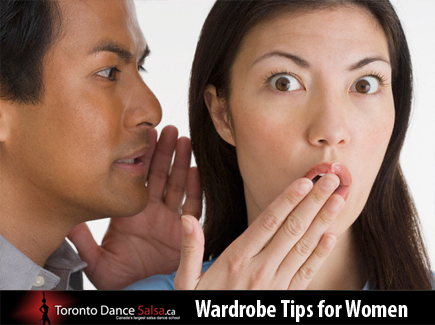
In the studio:
It’s best to wear something form fitting (i.e., not too loose as clothing that shifts around can cause “wardrobe malfunctions” during turn patterns). Also be sure to wear shorts or pants, especially if you’re in a higher level or specialty dance class – you can never be sure when dips or tricks will be taught in a class and a skirt or dress might make it difficult to execute more complicated moves or leg styling.
At the club:
Tops that “stay put” and shorts or pants in light-weight fabrics. Skirts and dresses are also great but be sure to do the “Salsa spin” test before going out to dance – make sure the skirt or dress stays “down” when you spin, turn and style. Dresses that are too long, too flowy or too tight are not ideal for dancing as there is not much opportunity for adjustment or “wardrobe checks” once you’re in the middle of a dance.
Shoe options for women:
Ballroom shoes
The popular option for women are Ballroom or Salsa shoes. They are the most formal salsa footwear and have suede soles which need to be brushed after every usage to maintain their quality and are made with special arch support and cushioning. Women prefer Ballroom/Salsa shoes to any other dance shoe because they come in the most versatile styles and can go with pretty much any outfit. If you are a new dancer it’s best to choose a heel height of 1.5″ to 2″. More experienced dancers prefer heels of 3″-4″ but be mindful that higher heel heights can be painful to dance in for a full night of dancing if you’re not use to dancing in heels.
There are a number of shoe companies that make beautiful Salsa dance shoes – Burju and Natural Spin both make beautiful and stylish Salsa shoes, with companies like Capezio and SupaDance making more traditional ballroom styles.
Jazz Sneakers
A great shoe for complete beginners or for practice. These shoes provide great arch support and the plastic split soles are good for spinning and the added cushioning is very comfortable. Bloch and Capezio both produce good jazz sneakers.
Jazz Slippers
Like the name implies, these shoes are made of supple leather that fits like a slipper and come in slip on or lace up versions. Some slippers have a suede sole which is more suitable for multiple turns. Others have a plastic split sole (like sneakers) which is easier to maintain but not as easy to spin with.
Getting Past Being “Just a Beginner”
“Once you become really addicted to salsa you might want to start thinking about organizing your closet into “Salsa friendly” clothing.”
As a new dancer you might feel like you’re “stuck” in the beginner phase – aside from going out to practice your new combos and leading and following technique, there are some technique drills that you can do at home (on your own) for 10-20 minutes a day that will make a huge contribution to building your muscle memory and how quickly you can learn (and retain) material that you learn in class.
(1) Practice your foundation footwork
Your salsa basic steps and simple weight transfer on the spot to the correct salsa rhythm
(2) Upper body isolation exercises
Practicing rib cage/core isolation movement from side to side will train your body to maintain posture and start to develop that smooth body rhythm required in salsa moves execution
(3) Listen to a lot of salsa music at varying tempos.
Use a salsa timing tool (like the Salsa Beat Machine) to test whether or not you are counting the beats properly and dancing on time.
Here is a list of slow to medium tempo songs for at home practice and ear training:
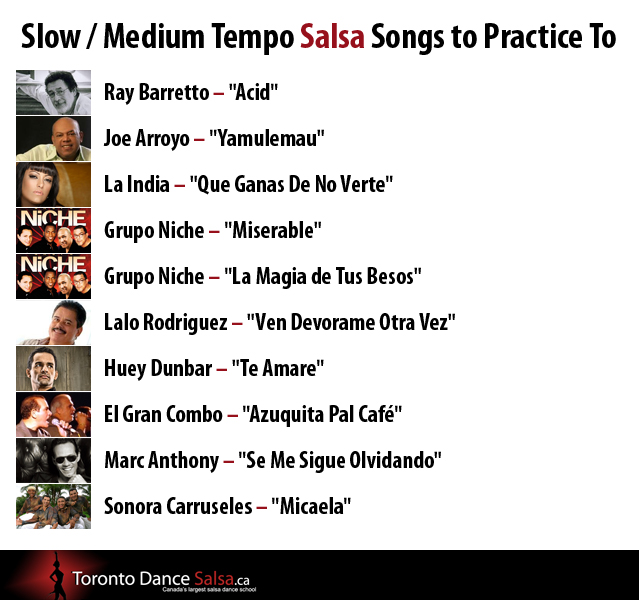
Going Out – Club Night vs. Outing vs. Social
“While all three are events where you can practice your social dancing, there are subtle differences between them.”
So you’ve been taking lessons for a few weeks and it’s time to dive into the Salsa dancing social scene. You’re looking up the different types of events hosted by clubs and dance studios and you see that some places call their events “Club Nights”, other places call them “Outings” and everywhere there are things called “Socials”.
While all three are events where you can practice your social dancing (i.e., dancing with a variety of people from dance studios, and different levels of experiences), there are subtle differences between them. Here is a “Coles notes” guide to help you choose where you start practicing your social dancing.
“Club Night”
A club night is a Latin dance night hosted by a nightclub (that might not necessarily be a Latin themed night club). Club Nights generally have names like “Tropical Thursdays” or “Bachata Nites” or “Salsa Fridays”. These nights are hosted by the nightclub and often offer a free class (included in the price of cover at the door) and sometimes feature live music in addition to a DJ that specializes in Latin music.
The free class provided by a nightclub will usually taught by the same instructor from week to week, and sometimes this instructor is affiliated with a studio (but they don’t have to be). Checking the web-site of the club will show you a schedule of who is teaching on what night and the theme of their Latin nights (some clubs have more than one Latin night). Note that nights that state a specific type of dance in the title (like Salsa, Bachata or Kizomba) will feature mostly that type of music on that night, with a small mix of other Latin music types (which can include Merengue, Reggaeton and Kuduro).
Club nights tend to be more “upscale” than the other types of social nights, with the crowd being a mix of dancers and non-dancers alike.
“Outing” or “Parties”
An Outing (sometimes called a Party) is when a dance studio or company hosts a Latin night at a nightclub or special event venue. The host studio will host a free lesson (some studios provide one “all levels” lesson, some provide a beginner and intermediate lesson to cater to varying skill levels), which is included in the price of cover. Checking a studio’s website and special event listings will tell you what time the lesson is and if there is one or two lessons.
While these events are open to the public, Outings are mainly promoted to and attended by the students from the host studio and their friends. Dance studios host Outings in order to encourage their students to mix and mingle with fellow students from other classes and levels to practice their social dancing in a club environment but without the pressure of a formal “Club Night”.
Outings are a great way for new dancers to check out a dance studio’s style and community. Usually you can meet the Director or a senior level dance instructor from the host studio at the Outing and talk to them about their studio if you’re interested in taking lessons from them.
Outings are more casual that Club Nights (although people do get dressed up for Outings, especially if it’s a special event like a themed Party for Valentine’s Day or Hallowe’en) and, from time to time, can also feature performances of student, amateur and pro dance teams from the host studio.
“Social”
A Social is when a dance studio or company hosts a practice session in a dance studio. A Social is the most casual of all three social events and is a true practice session in that no classes or instruction is provided at the event.
Socials are also open to the public and are mostly attended by dancers from the host studio or company, but some long-standing and popular Socials are attended by dancers from many different studios and can be a good place to meet dancers from other studios, especially dancers from higher levels who have more social dancing experience.
Salsa Etiquette – 10 Simple Rules
“Like all social activities, Salsa dancing has a set of etiquette do’s and don’ts.”
Like all social activities, Salsa dancing has a set of etiquette do’s and don’ts. Most experienced dancers know the proper etiquette of dance floor behaviour, but it’s easy for a new, and enthusiastic dancer to inadvertently commit a “faux pas” and unwittingly get put on the “avoid” list before he/she can say “bailamos!”
Following these 10 simple rules will keep you off the “avoid” list and ensure you have a long and happy social dance life:
Don’t interrupt
When asking someone to dance, be sure to observe (on your approach towards them) that they are not in a conversation with someone. Interrupting a conversation between two people is never polite and this is no exception in a dance environment.
Be assertive, not aggressive.
When asking someone to dance (who is clearly available to dance), please ASK them to dance, do not just grab their hand and drag them on the dance floor. This is a rule for guys and girls alike – gentlemen, be a gentleman and always offer a hand and lead your lady on to the dance floor. Ladies, don’t be shy to ask a guy to dance!
Be polite.
When turning someone down from a dance (for any reason) do not then turn around (during the same song) and ask someone else to dance or say yes to someone else’s offer to dance, even if the offer is from someone that you’ve been waiting to dance with all night. If you have turned down an offer to dance, good manners dictate that you must sit out that dance.
Don’t hog.
Unless you are very good friends with the person you are dancing with, do not “hog” a dancer (especially if they are a popular partner) for more than 2 dances. Even dancers who are known couples should not dance together all night – Salsa dancing is a social activity and part of being an active and friendly member of the community is to change partners every 2 songs or so.
Keep dry and odors to a minimum.
If you are especially sweaty (it happens) then be sure to either dry off frequently or change outfits! A good heavy duty deodorant goes a long way, but strong perfume and cologne does not (many dancers are allergic and strong perfume or cologne is usually a turn off). ‘Nuff said.
Adapt to your dance partner.
Leaders, this means getting to know your partner (especially if you’re dancing with someone the first time) and BE GENTLE! Followers, this means keeping styling to a minimum in the beginning of a dance until you know your partner’s skill level and being attentive to your Leader’s technique. All experienced dancers will tell you that every dancer is different and that you must adapt to your Leader’s/Follower’s strength and weaknesses. Paying attention to your dance partner and their comfort level in turn patterns, embrace, and styling will make for a more enjoyable experience for both of you.
Stick to your lane.
As much as possible, be conscientious about staying in your dance space. Real estate on a crowded dance floor is a prized possession but should not be fought over. When you find a spot on the dance floor be mindful of the couples around you and adapt your dancing according to how much space there is. If the dance floor is crowded keep your turn patterns small and simple, and styling to a minimum. More dance floor space means more room to breathe and the possibilities of practicing your more fancy moves, but always remember that all dancers have a right to be on the same dance floor and therefore should all have equal opportunity to room to dance. Nobody enjoys a shoe heel stab in their foot or an elbow knock on the head – a night of Salsa dancing shouldn’t be a game of bumper cars!
Don’t be a lurker.
If you are not dancing, steer clear of the dance floor. Do not lurk or linger on the dance floor space as you will probably be taking up precious dance floor real estate and the couple dancing next to you would probably really appreciate it if you moved back just a foot or so. Appropriate places to hang out, socialize, and watch the action is up against the bar or (literally) on the side-lines. If you need to get around the club or studio to get to the coat room, washroom or exit, skirt the edge of the dance floor, do not cut through the middle. Walking through a dance floor at any other time than at the beginning or end of a song is not cool.
Relax, cowboy, it’s just dancing.
This rule is more for Leaders, but can also apply to Followers. Stick to turn patterns that you know you can execute safely and comfortably. In Salsa dances this means avoiding lifts, tricks (unless you are an experience professional dancing with another seasoned professional) and complicated dips. In Bachata and Kizomba dances this means avoiding deep dips, leg tricks and body movement styling – without proper technique instruction these can end up feeling awkward and uncomfortable, and in the case of dips and tricks, can cause injury.
Relax, cowboy, it’s just dancing.
No, this isn’t a typo. This last rule bears repeating. Remember that everyone on the social dance floor is there to enjoy him/herself in an easy-going atmosphere. Performance and “serious” dancing has a time and place (like on a stage) and it’s not on the social dance floor. Social dancing isn’t a test so you don’t need to execute absolutely everything you know as much and as fast as possible. Breathe, relax, smile, and have fun. Every dance is a journey, so enjoy the ride.
Celebrity Salsa
“It’s so hot, Ellen’s doing it!”
Check out Ellen DeGeneres and actor Sofia Vergara tearing up the dance floor with some Merengue!
“What’s good enough for the POTUS…”
POTUS Barack Obama grooves out with Mexican popstar Thalia (with Michelle’s permission). Starts at 3:25.
“Not just for the movies”
Actor Vanessa Williams, who learned how to ballroom and Salsa dance for the movie “Dance With Me” takes her skills to the social dance floor.
Salsa on Screen
Our top 5 favourite dance movies and the scenes that helped make Salsa a world-wide phenomenon:
#5: Ben Stiller’s awkward introduction to salsa in the Club Scene in “Along Came Polly” (2004)
Why we love this scene:
The movie (in our opinion) was just ok, and to be honest, none of the actors really learned how to salsa for this movie, but the club scene captures perfectly the typical start to why someone decides to take Salsa dance lessons: a friend drags you to a club and promises you an “amazing night of dancing” and you end up kind of flailing around the dance floor a bit before you get hit in the head or stepped on one too many times and you end up on the sidelines, watching and wishing you could participate.
Summary: We’ve all been there. Take some lessons, practice and just go with it. It gets better, we promise.
#4: The opening scene of “Salsa, the Motion Picture” (1988) Tag line: “It’s Hot!”
Why we love this scene:
The 80’s answer to Saturday Night Fever was a slew of motion pictures featuring dance (Footloose, Dirty Dancing, Flashdance, Fame) and the Latin dance community jumped on the bandwagon with “Salsa, the Motion Picture”. Let’s be honest, the acting wasn’t the greatest and the hair-dos, wardrobe and set dressing would leave the movie really dated but we can’t deny the infectiousness of the opening scene in the garage where the main character, Rico, a young Puerto-Rican in east Los Angeles who is a mechanic by day and dancer by night (sound familiar?), grooves out with his fellow mechanics and girlfriend to a 1980’s “pop-ified” salsa tune.
The movie wasn’t ground breaking or memorable (did you even know it existed before you read this article?) BUT it introduced L.A. style salsa to the world and could arguably be the “spark” that started the Salsa dance craze in North America.
Summary: Salsa dancers are always dancing. Think that having two dance scenes in the first 10 minutes of a movie is ridiculous? Go and watch Salsa dancers tear up the dance floor for 4 hours straight, 7 days a week. If you play the music, Salsa dancers will dance, no matter where they are.
#3: Vanessa Williams and Chayanne in the Club Scene in “Dance With Me” (1998)
Why we love this scene:
Aside from watching this gorgeous couple dance together, this scene captures perfectly the vibe of a great night of dancing. It can be packed, hot, sweaty and loud, but it doesn’t matter. All that matters is the two of you on the dance floor, smiling at each other and having a good time. The “Casino Rueda” portion of the dance sequence captures the fun of a social night of dancing – meeting new people, learning new moves and drinking in the energy of your fellow dancers. “Casino Rueda” is Cuban style of salsa that is danced in a circle and features pairs dancing in synch according to directions called out by a Leader. Rueda moves feature fun styling tricks by the guys and frequent partner changes.
Summary: When you’re getting frustrated with your dancing, remember why you started dancing in the first place – that high you get from being in the club, meeting and dancing with new and old friends alike.
#2: Patrick Swayze and Cynthia Rhodes tear up the dance floor in the “Johnny’s Mambo” scene in “Dirty Dancing” (1987)
Why we love this scene:
This is the scene where we (and Baby, played by Jennifer Grey) see Johnny (Patrick Swayze) perform for the first time with his dance partner (played by Cynthia Rhodes). While the choreography is most definitely more Mambo than Salsa (think of it as the “ballroom-y” cousin of Salsa), the salsa basic moves are still present so technically it still counts as a salsa dance sequence.
For those of us who saw this movie when it first came out, we will always remember the very first time we saw the handsome Mr. Swayze twisting his hips in that mambo sequence – we were Baby. Young, innocent and completely enraptured with the idea of being that sexy, confident and graceful dance partner. Cynthia Rhodes is no slouch either and we’re sure her legs inspired more than one or two young men to get on the dance floor for a chance to twirl a girl around the way Swayze does in this scene.
Summary: “Dirty Dancing” brought partner street dances like salsa and lambada into the “main stream” – not just danced by those of Latino descent, but by anyone who just loved to dance. Taking the idea of partner dancing out of the more formal ballrooms and into the steamy clubs and studios. Thank you, Mr. Swayze.
For our Number One spot is technically two clips, but from the same movie and those of you familiar with the film will hopefully forgive us and agree that these two scenes are inseparable:
#1: Patrick Swayze and Jennifer Grey’s awkward first performance in the Mambo Magic scene in “Dirty Dancing” and The Finale of “Dirty Dancing”
Every single salsa performer (amateur or professional) has had one of these performances – timid, awkward and mechanical. The kind where you’re concentrating so hard on the choreography that you forget to smile, breathe, and enjoy the experience. We have also had one too many experiences with bad lifts. But with the bad (and cringe-worthy moments) comes the good – there’s nothing like a dance partner who is there to take care of you and help make you look your best, even if your face is completely blank for the entire show.
This scene also reminds us of when we’ve had a really bad day of dancing – you feel “off” and completely out of it. You also feel like everyone is staring at you and “noticing” how “bad” you’re dancing (in reality nobody notices – trust us!). But for every cloudy day there is a silver lining…..like this….
Why we love this scene:
Is there anything not to love in this scene? Baby has overcome all her shyness and blossomed into a confident, sexy and fun dancer. She has embraced what she is good at and laughed at what she’s not. Johnny is the perfect partner – he looks good (we assume he smells pretty good too), he’s attentive and knows how to make a gal feel her best in a dance.
From Johnny’s swagger down the centre aisle (with a chorus of backup dancers to boot) and the nailing of that iconic superman lift and the final wrap of the entire movie with everyone in the room dancing (a particular favourite moment is when the elderly ladies shrug off their shawls to groove with each other), this final scene epitomizes the high you get when you realize you’re “there” – in the moment of the dance, able to focus on having fun and enjoying the ride rather than focusing on moves or choreo or “looking good”. You own the dance floor rather than it owning you.
Summary: Nobody puts Baby in a corner.
FUN: Salsa Memes
